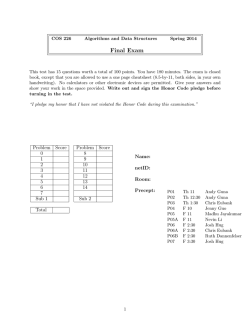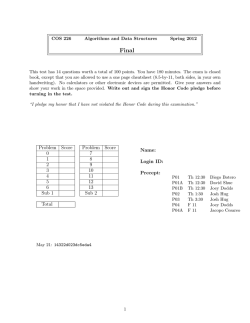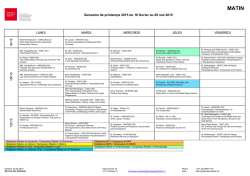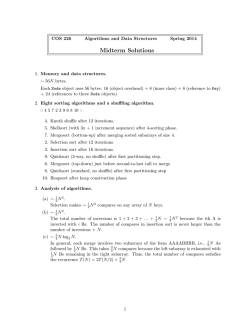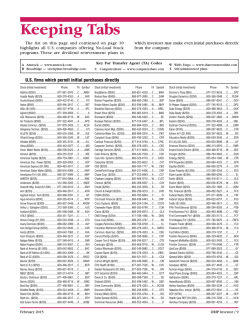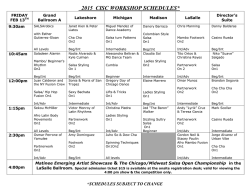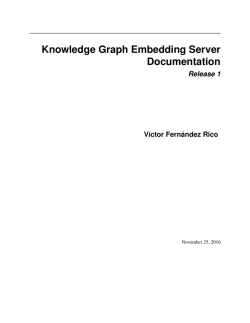
Programming Paradigms: Exercises
Programming Paradigms: Exercises
January 27, 2015
1
Abstract machines
These questions are about the von Neumann-machine and the interpreter for
the functional language from the first lecture. To solve these exercises, edit the
files and load them into the Haskell REPL (Read-Eval Print Loop) ghci.
1.1
Virtual Imperative Machine
Exercise 1
Make sure you can run the examples given in the file VM.hs.
[*]
Exercise 2
What does the example loop program below do?
[*]
exLoop = Machine
[Load 0 "zero"
,Load 1 "one"
,Load 1000 "counter"
,Print "counter"
,BinOp Sub "counter" "one" "counter"
,BinOp Neq "counter" "zero" "cond"
,RelJump "cond" (-4)
,Halt]
initMemory
Express it in some language with imperative features of your choice (e.g.
C(++), Java(Script), Python, ...).
Exercise 3
How do you multiply two numbers without using Mul?
Exercise 4 How do you formulate an if-statement in the language? Translate
this snippet that prints the maximum of two numbers. Run it with the memory
initialized for the variables x, y, etc:
if (x > y) {
print(x);
} else {
1
[*]
[*]
print(y);
}
Exercise 5
How do you calculate the absolute value of a number?
Exercise 6 Make a function that loops a program forever. It takes a program
as input and it returns another program that runs the input program forever.
An appropriate type of the loop is:
[*]
[**]
loop :: [Instruction] -> [Instruction]
The following program should print 1 indefinitely:
exOnes = Machine (loop [Print "one"]) [("ipLoc",0),("one",1)]
(press Ctrl+C in ghci to stop it!)
The following Haskell functions are helpful:
(++)
:: [a] -> [a] -> [a] -- xs ++ ys concatenates the two lists xs and ys
length :: [a] -> Int
-- length of a list (to calculate the jump offset)
Use your loop constructor to print the infinite sequence of triangle numbers
0, 1, 3, 6, 10, ... (calculated as 0, 0+1, 0+1+2, 0+1+2+3, ...).
Exercise 7 Make a program builder function for if statements with greaterthan. This amounts to making a function with the following type:
[**]
ifGt :: Address -> Address -> [Instruction] -> [Instruction]
-> [Instruction]
Thus a call to ifeq addr1 addr2 ins1 ins2 checks if the value in addr1 is
greater than the one in addr2. If it is, it runs the instructions ins1, otherwise
ins2.
Test your implementation by making a program that prints the maximum
of three numbers.
1.2
Functional Language
Exercise 8 A) What Value does eval (Lam "x" (Var "x")) evaluate to?
You cannot print this value in ghci, but which value is it?
B) What happens, step by step, in the evaluation of
eval (App (Lam "x" (Var "x")) (Val (Number 1)))?
[*]
Exercise 9
[*]
Make sure you can run the examples given in the file Fun.hs.
Exercise 10 Import the max function from Haskell using Bin, and use it to
write a lambda term that calculates the maximum of three numbers.
2
[*]
Exercise 11
Add an if-then-else construct to the language where false is
represented with the number zero.
Add the constructor IfThenElse Expr Expr Expr to the Expr-datatype,
with the evaluation semantics that IfThenElse p t f means the expression p
is evaluated, and if it is nonzero evaluates t, otherwise f.
Import the > function (greater-than) from Haskell using Bin and the interpretation of true and false as above, and use it and your IfThenElse-construct
to write a lambda term that calculates the maximum of three numbers.
[**]
Exercise 12 Show that the Bin constructor is redundant by making an equivalent function that does to use it:
[***]
bin :: Op -> Expr -> Expr -> Expr
Hint: Use Val.
2
Generalities
2.1
Paradigms, Languages, Features
Consider the language C++ (or your favourite programming language, ...).
Exercise 13 Write a list of features (programming constructs) implemented
in this language. Be as exhaustive as you can (list at least 10 features).
[*]
Exercise 14 For each programming paradigm (Imperative, OO, etc.), evaluate how well this language supports that paradigm. Argue using the list compiled in the previous answer.
[*]
Exercise 15 Can you identify a paradigm not studied in the course which is
supported by this language?
[***]
2.2
Types
Exercise 16
Give a meaningful type to the following values.
1. 4
2. 123.53
3. 1/3
4. π
5. ’c’
6. “Hello, world!”
3
[*]
7. -3
8. (unary) 9. (binary) +
10. sin
11. derivative
Exercise 17 Explain the meaning of the following types. (Hint: what kind
of values can inhabit those types?)
[**]
1. String
2. String → String
3. String → String → String
4. (String → String) → String
5. String → (String → String)
6. (String → String) → (String → String)
One can not only parameterize over values, but also over types. (Eg. in
Java, generic classes).
For example, the following type is a suitable type for a sorting function:
it expresses that the function works for any element type, as long as you can
compare its inhabitants.
∀ a. (a → a → Bool) → Array a → Array a
Exercise 18 Does sort in your favourite language have a similar type? How
close/far is it?
[**]
Exercise 19
[***]
Consider the type
∀a b.Pair a b → Pair b a
What programs can possibly have this type?
4
3
Imperative Programming
3.1
Gotos to loops
Consider the algorithm:
Preliminary: A is an array of integers of length m and B is an array of
integers of length n. Also the elements from both arrays are distinct (from
the elements in both arrays) and in ascending order.
Step1: if n or m is zero STOP. Otherwise if m>n, set t := blog (m/n)c
and go to Step4, else set t := blog (n/m)c.
Step2: compare A[m] with B[n + 1 - 2t ]. If A[m] is smaller, set n := n
- 2t and return to Step1.
Step3: using binary search(which requires exactly t more comparisons),
insert A[m] into its proper place among B[n + 1 -2t ] ... B[n]. If k is
maximal such that B[k] <A[m], set m := m - 1 and n := k. Return to
Step1.
Step4:(Step 4 and 5 are like 2 and 4, interchanging the roles of n and m,
A and B) if B[n] <A[m+1-2t ], set m := m - 2t and return to Step1.
Step5: insert B[n] into its proper place among the As. If k is maximal
such that A[k] <B[n], set m := k and n := n - 1. Return to Step1.
Exercise 20 Implement binary search without gotos in the context of the
algorithm. There is a slight change compared to the classical algorithm, since
the scope of the search is different. 1
[*]
Exercise 21 Step1 may require the calculation of the expression blog (m/n)c,
for n ≥ m. Explain how to compute this easily without division or calculation
of a logarithm.
[-]
Exercise 22
take t steps ?
Why does the binary search mentioned in the algorithm always
[*]
Exercise 23 Explain the behaviour of the algorithm for the arrays A = {87,
503, 512} and B = {61, 154, 170, 275, 426, 509, 612, 653, 677, 703, 765, 897,
908}.
[*]
Exercise 24 Implement the above-mentioned algorithm without using gotos
in a programming language of your choice. Check your implementation with
the A and B from the previous question.
[**,@2]
1 If
that is too easy, do it for red-black trees.
5
3.2
Control flow statements to gotos
Exercise 25
Translate the following for loop with explicit gotos:
[*,@2]
for (statement1; condition; statement2)
loop_body
Exercise 26
Translate the following foreach loop with explicit gotos:
[*]
foreach i in k..l do
body
Exercise 27
Translate the do/while construct.
[*]
Exercise 28 Translate the switch/case construct.
(If you want to make sure your translation is correct you should check the
specification of the C language. http://www.open-std.org/jtc1/sc22/wg14/
www/docs/n1124.pdf)
[*,@2]
Exercise 29
[*]
3.3
Translate the insertion sort algorithm.
Pointers and call by reference
Exercise 30 Create a binary search tree where nodes contain integer number
in C/C++/Java. Implement a function that adds a value to the tree and one
that deletes a certain value from the tree.
[*]
Exercise 31
Write a recursive pre-order traversal of the above tree.
[*]
Exercise 32
Write a swap function using call by reference.
[*]
Exercise 33
Write a swap function using call by value.
[*]
Exercise 34 Does Java use call by reference or call by value? Give examples
to support your answer.
[**]
Exercise 35 Write down pros and cons of using call by reference vs. call by
value. (Ease of use, performance, ...)
[**]
3.4
More on control flow and pointers: Duff ’s device
Duff’s device is an optimization idiom for serial copies in the language C. The
fragment below lists first the original code, then Duff’s optimization.
6
/* (Almost) original code */
int main() {
short *to, *from;
int count;
...
{
/* pre: count > 0 */
do
*to++ = *from++;
while(--count>0);
}
return 0;
}
Many things happen in the assignment “*to++ = *from++;”. Can you
figure out what exactly?
Exercise 36 Translate the above to multiple statements, so that for each of
them only one variable (or memory location) is updated. Explain in your own
words what happens (draw a picture if necessary).
[*]
Duff optimised the above code as follows:
/* Duff’s transformation */
int main() {
short *to, *from;
int count;
...
{
/* pre: count > 0 */
int n = (count + 7) / 8;
switch(count % 8){
case 0:
do{
*to++ = *from++;
case 7:
*to++ = *from++;
case 6:
*to++ = *from++;
case 5:
*to++ = *from++;
case 4:
*to++ = *from++;
case 3:
*to++ = *from++;
case 2:
*to++ = *from++;
case 1:
*to++ = *from++;
} while (--n > 0);
}
}
return 0;
}
Exercise 37
Translate the switch statements to gotos.
7
[**]
Is the second program really equivalent to the first?
Exercise 38 Show that the instruction “*to++ = *from++” will be executed
count times in the second program.
[-]
Exercise 39
[****]
Explain the equivalence by a series of program transformations.
Exercise 40
Can you guess why Duff expects the second program to be
faster? What instructions are executed in the first program but not in the
second?
[-]
Further reading
For the original email in which Tom Duff presented his “device”, see
http://www.lysator.liu.se/c/duffs-device.html
You can see the assembly code generated by gcc by compiling with
gcc -S <filename>.
3.5
From recursion to explicit stack
Exercise 41
Consider the following tree data structure:
[**,@2]
struct tree {
int v;
struct tree *l, *r;
};
typedef struct tree Tree;
Implement a pre-order traversal, using explicit stack(s).
Consider the following recursive equation for computing Fibonacci numbers:
f ibn+2 = f ibn+1 + f ibn
Exercise 42 Implement the recursive function computing the n-th Fibonacci
number based on the expression above.
[*]
Exercise 43 What is the complexity of the computation? (How many calls
will there be to compute f ibn ?)
[*]
8
Exercise 44 Implement a slightly-optimized recursive function for the same
purpose, using an accumulator parameter.
[*]
Exercise 45 Implement a version of each of the two functions above by using
an explicit stack.
Consider the following function:
[**]
void move_many(int n, int source, int intermediate, int target) {
if (n != 0) {
move_many(n-1,source,target,intermediate);
move_disk(source,target);
move_many(n-1,intermediate,source,target);
}
}
Exercise 46
Remove recursion, using an explicit stack.
[**]
Exercise 47
Eliminate the tail call. (Do not use the stack for it).
[**]
Exercise 48 The structure of the other call is particular: it is possible to
recover the arguments of the caller from the arguments of the call. Use this
property to avoid using the stack for these arguments.
[***]
Exercise 49
[**,@3]
Consider the Ackerman function:
int a(int m, int n) {
if (m == 0)
return n+1;
else if (n == 0)
return a(m-1,1);
else {
return a(m-1,a(m,n-1)); // note the non-tail call
}
}
Transform the tail calls to loops.
Exercise 50
stack)
Implement the Ackermann function without recursion. (use a
[**]
Exercise 51
Implement the algorithm from the previous section without
loops (only recursion allowed).
[**]
Exercise 52
[**]
Translate the quicksort algorithm.
9
Exercise 53 For each of the following: implement the algorithm as a recursive
function. (And remove the loop!)
1. -- n given
x = 1
while n > 0 do
b = least_significant_bit(n);
n = n / 2;
x = x * x + b;
return x
2. a = 0
b = 1
for i in [1..n] do
c = a + b
a = b
b = c
return a
10
[**]
4
Object-Oriented Programming
Consider the following code, in C# syntax:
interface Monoid {
Monoid op(Monoid second);
Monoid id();
};
struct IntegerAdditiveMonoid : Monoid {
public IntegerAdditiveMonoid(int x) {
elt = x;
}
public IntegerAdditiveMonoid op(IntegerAdditiveMonoid second) {
return new IntegerAdditiveMonoid(
elt + second.elt);
}
public IntegerAdditiveMonoid id(){
return new IntegerAdditiveMonoid(0);
}
int elt;
};
4.1
Explicit method pointers
Exercise 54 Translate the above code to a C-like language, using explicit
method pointers. Store the method pointers directly in the object. (Hint: you
can simply consider the interface as a class without fields.)
[*]
Exercise 55
Same as above, but using method tables.
[*]
Exercise 56
Briefly recap: what is a monoid, mathematically?
[-]
Exercise 57 Give two examples of data types that can be considered monoids.
(Hint: Strings would form a monoid under the appropriate structure; what is
the structure?
[-]
Exercise 58 Write another instance of the monoid interface, using one of the
examples you found. Also write its translation to a C-like language.
[*]
Exercise 59
a.op(b).
Assume variables a,b of type Monoid. Translate the expression
[*]
Exercise 60
Assume to objects x,y of two different instances of Monoid
are bound to the variables a,b. Explain what happens at runtime when the
expression is evaluated. (Which code is executed?)
[*]
11
4.2
Co/Contra variance
Surprise: the above C# code defining the IntegerAdditiveMonoid is refused by
the C# compiler:
> gmcs Monoids.cs
Monoids.cs(6,8): error CS0535: ‘IntegerAdditiveMonoid’ does not implement
interface member ‘Monoid.op(Monoid)’
Monoids.cs(2,11): (Location of the symbol related to previous error)
Monoids.cs(6,8): error CS0535: ‘IntegerAdditiveMonoid’ does not implement
interface member ‘Monoid.id()’
Monoids.cs(3,11): (Location of the symbol related to previous error)
Compilation failed: 2 error(s), 0 warnings
Exercise 61 What if the method op would compile? Define objects a,b, of
appropriate types, so that a.op(b), if is run, would result in a run-time error.
[*]
Exercise 62 What if the method id would compile? Could you construct a
similar run-time error? (Hint: do the translation job if the answer is not obvious
to you.)
[*]
Exercise 63
[**]
Explain the error messages in terms of co-/contra-/nonvariance.
Exercise 64 The corresponding program in Java behaves differently. Briefly
explain how, consult the Java Language Specification (JLS), and back your
answer with the appropriate clause(s) in the JLS.
[***]
Exercise 65 Can you change the code so that the (current) C#-compiler
accepts it? What is the problem then?
[-]
5
5.1
Functional Programming
Algebraic Data Types and Pattern Matching
Exercise 66
Write functions between the types
[*]
(Either A B, Either C D)
and
Either(Either(A, C) (B, D)) (Either(A, D) (B, C))
.
Exercise 67
Define an algebraic type for binary trees
[*]
Exercise 68
define an algebraic type for arithmetic expressions (+, *, ...)
[*,@5]
12
Exercise 69 Define a simple interpreter for the above type; that is given an
expression, compute its value.
[*,@5]
Exercise 70 Translate the above 2 structures to an OO language. (Hint:
One class corresponds to leaves, one to branching.)
[*,@5]
Exercise 71
Translate the interpreter to an OO language. You are not
allowed to use ’instanceof’
[*,@5]
Exercise 72
’instanceof’.
[*,@5]
5.2
Translate the interpreter to an OO language. You must use
Currification and partial application
Exercise 73 Define a function f following this spec: given a integer, return
it unchanged if it is greater than zero, and zero otherwise. (The type must be
Int → Int.)
[*,@5]
Exercise 74
function f.
Assuming a function max : (Int × Int) → Int, define the
[*,@5]
Exercise 75
Define a function max’, by currifying the function max.
[*,@5]
Exercise 76
Define f using max’.
[*]
5.3
Higher-order functions
Assume the filter, map, foldr functions as in the Haskell prelude. f comes
from the previous section.
Exercise 77 For each of the following expressions, remove occurences of the
higher-order functions by inlining them.
exp1
exp2
exp3
exp4
exp5
=
=
=
=
=
map f
filter (>= 0)
foldr (:) []
foldr (++) []
foldr (\ x xs -> xs ++ [x]) []
Consider the following imperative program:
for (i=0;i<sizeof(a);i++)
if (a[i].grade >= 24)
*b++ = a[i];
13
[*,@5]
Exercise 78
How would the same algorithm be naturally expressed in a
functional language? (Use functions from the Haskell prelude to shorten your
code)
[*,@4]
Assume we represent a vector as a list of integers.
Exercise 79 write a function that does the dot-product of two vectors using
explicit recursion and pattern matching.
[*]
Exercise 80
In the above code, abstract over sum and products on integers.
[*]
Exercise 81
module?
Can you find the functions you created in the Haskell Data.List
[**]
Exercise 82 The standard function insert inserts an element into an ordered
list, for example
[]
insert 4 [1,3,5,7] = [1,3,4,5,7]
Define a function
sort :: [Integer] -> [Integer]
to sort lists, using insert.
Exercise 83
5.4
Express sort in terms of foldr (do not use explicit recursion).
[]
Closures
Consider the program:
test1 xs = foldr (+) 0 xs
test2 xs = foldr (*) 1 xs
Exercise 84
Identify higher-order applications in the above program.
[*]
Exercise 85 Assuming that xs are lists of integers, replace the above uses
of higher-order application by explicit closures. (Hint: you need to also change
the definition of foldr).
[*]
Exercise 86 Add the following lines to the above program and repeat the
above 2 exercises.
[**,@5]
replace a b xs = map (\x -> if x == a then b else x) xs
moment n xs = sum (map (\x -> x ^ n) xs)
14
Exercise 87
Eratosthenes’ sieve is a method for finding prime numbers,
dating from ancient Greece. We start by writing down all the numbers from 2
up to some limit, such as 1000. Then we repeatedly do the following:
[*]
The first number in the list is a prime. We generate it as an output.
We remove all multiples of the first number from the list—including that
number itself.
Loop.
We terminate when no numbers remain in our list. At this point, all prime
numbers up to the limit have been found.
Write the algorithm in Haskell.
Exercise 88
Consider the following algorithm:
[*]
primes = sieve [2..1000]
sieve (n:ns) = n:sieve (filter (not . (‘isDivisibleBy‘ n)) ns)
x ‘isDivisibleBy‘ y = x ‘mod‘ y == 0
Inline the call of function composition in the above as a lambda abstraction.
The only remaining higher-order function is filter.
Exercise 89 Write a version of filter which takes an explicit closure as an
argument. Remember to write (and use) an apply function. Hint: in order to
test your program you need to define an example parameter, such as (>= 0),
etc.
[*]
Exercise 90
[*]
Re-write sieve using the above.
Exercise 91
Write a version of sieve in imperative (or OO) language, by
translation of the answer to the previous exercise. (eg. you can not use arrays
instead of lists). (Hint: write this one as a recursive program).
5.5
[**]
Explicit state
Consider a binary tree structure with integer values in the nodes.
Exercise 92 In the Java version, write a function that replaces each element
with its index in preorder traversal of the tree.
Here is how to get and set the “state of the world” using IP from the lecture
notes.
getState :: IP State
getState = \s -> (s,s)
setState :: State -> IP ()
setState newState = \s -> (newState,())
15
[*,@5]
Exercise 93
Translate the function above to Haskell thinking of it as an
imperative algorithm. You should use IP from the lecture notes. What is the
“state of the world” in this case?
[**,@5]
Exercise 94 Rewrite the Haskell version, in such a way that passing “state
of the world” is made visible as such, that is, eliminate your usage of IP.
[*]
5.6
Laziness
There are no lazy languages that permit mutation.
Exercise 95
5.6.1
Why not?
[*** ,@5]
Lazy Dynamic Programming
Consider a the function computing the fibonacci sequence:
fib 0 = 0
fib 1 = 1
fib n = fib (n-1) + fib (n-2)
Exercise 96 Estimate the time-complexity of computing fib n.
One can make the above computation take linear time by saving the intermediate results in an array:
fibs[0] =
fibs[1] =
for i = 2
fibs[n]
[-]
0
1
to n do
= fibs[n-1] + fibs[n-2]
Exercise 97 Instead of specifying the order of filling the array via an imperative algorithm, let Haskell’s lazy evaluation take care of it. Write the definition
of the array fibs in Haskell.
[*]
Exercise 98
What portion of the array is forced when fibs!k is accessed?
Draw the graph of computation dependencies for k = 5.
[*]
Exercise 99 Write the Floyd-Warshall algorithm in your favourite imperative
language. Assume that there is no weight on edges; and you’re only interested
in whether there is a path between two given nodes, not the number of steps in
the path.
Note that the best-case performance is Cubic.
[*]
Exercise 100 Repeat the above, but make sure you never overwrite a cell in
a matrix. (What do you need to do to make this at all possible?)
[*]
16
Exercise 101 Using the same formula, fill the Floyd-Warshall matrix using
an array comprehension in a lazy language (optionally use explicit thunks for
the contents of each cell). Discuss the best-case performance.
[*]
Exercise 102 Does your favourite spreadsheet program have strict, or lazy
logical disjunction operator? Test it.
[-]
Exercise 103
[-]
Can you write the Floyd-Warshall algorithm in it?
Exercise 104 Repeat the above steps with the algorithm to compute the
least edit distance. http://en.wikipedia.org/wiki/Levenshtein_distance
[**]
int LevenshteinDistance(char s[1..m], char t[1..n])
{
// for all i and j, d[i,j] will hold the Levenshtein distance between
// the first i characters of s and the first j characters of t;
// note that d has (m+1)x(n+1) values
declare int d[0..m, 0..n]
for i from 0
d[i, 0] :=
for j from 0
d[0, j] :=
to m
i // the distance of any first string to an empty second string
to n
j // the distance of any second string to an empty first string
for j from 1 to n
{
for i from 1 to m
{
if s[i] = t[j] then
d[i, j] := d[i-1, j-1]
else
d[i, j] := minimum
(
d[i-1, j] + 1,
d[i, j-1] + 1,
d[i-1, j-1] + 1
)
}
}
return d[m,n]
}
17
// no operation required
// a deletion
// an insertion
// a substitution
5.6.2
Lazy Lists (Streams)
Remember the sieve algorithm. Lazy lists can be (potentially) infinite, although
of course no program can evaluate all the elements of an infinite list. Nevertheless, using lazy lists can help us avoid building unnecessary limitations into our
code. Check that the sieve function also works given the infinite list [2..]—
the output should be the infinite list of all prime numbers.
Exercise 105
How would you find the first 100 prime numbers?
[*,@5]
Hint: start by answering the following questions on a simpler algorithm,
for example the function enumFrom which generates the infinite list of numbers
starting at a given one.
Exercise 106
Translate sieve to use explicit thunks.
Oh noes, this intro-
[*,@5]
duced higher-order function(s).
Exercise 107
Where are the new higher-order functions?
[**]
You know what’s coming...
Exercise 108
Remove higher-orderness using the best technique available.
[***]
Exercise 109
Write a version of lazy sieve in imperative (or OO) language.
[**,@5]
Since there are no more functions in the data, you can now display your
infinite lists.
Exercise 110
6
6.1
Do so for a few meaningful inputs, and interpret what you see.
[***]
Concurrent Programming
Channels and Processes
Exercise 111 Write a process that manages a bank account. It has a channel
for queries; which can be deposits and withdrawals. The answer is posted to a
channel that comes with the query. (Note: you cannot use references to store
any state – see variable-managing process for inspiration)
[*,@6]
Exercise 112 Write a client for the above process that move “money” from
an account to another. (“transaction”)
[*,@6]
18
Exercise 113 Assume that withdrawals/deposits can fail. (For example if
there is too much/litte on the account). Modify the server process accordingly.
[*,@6]
Exercise 114
Is the total amount of money a constant of your system?
(Consider that transactions may fail in the “middle”.) How can you ensure that
it is? Write the corresponding code.
[**,@6]
Exercise 115 Implement a process that manages a semaphore. The process
should implement the requests P and V. (See the wikipedia article for explanation of semaphore, P and V). http://en.wikipedia.org/wiki/Semaphore_
(programming)
[*]
Exercise 116 Implement two library functions that help communicate with
the above server. (Hint: you may have to create channels.)
[*]
6.2
Explicit continuations
Consider the following outline for the “business logic” of a web-application:
session connection = do
items <- webForm connection "What do you want to buy?"
address <- webForm connection "Where do you want your stuff delivered?"
daMoney <- webForm connection "Enter your credit card details, now."
secureInDatabase daMoney (priceOf items)
placeOrder items address
Exercise 117
What is the purpose, and type of the webForm primitive?
[*,@7]
Exercise 118
Transform the type of webForm to take a continuation.
[**,@7]
Exercise 119 Break the above code into continuations, linked by the webForm primitive.
[**,@7]
Exercise 120
Outline what the webForm function should do. Discuss in
particular what happens if the user presses the “back” button in their browser.
[***,@7]
19
Recursion and continuations Remember your interpreter for arithmetic
expressions. It should have type:
Expr → Int
Let’s make continuations explicit. In this case, the result is not returned
directly, but applied to a continuation. Hence, the type becomes:
Expr → (Int → a) → a
Exercise 121
Write a wrapper for the interpreter which has the above type
[*]
Exercise 122 Replace every recursive call in the interpreter by a call to the
wrapper. (Hint: you must decide what is the “continuation” for every call, and
for this you must choose an order of evaluation!)
[***]
Exercise 123
[***]
7
Unfold the usage of the interpreter in the wrapper.
Logic Programming
In this section, exercises are sometimes formulated both in Prolog and Curry
syntax; as indicated in the margin.
7.1
Metavariables and unification
Exercise 124 What is the result of each of the following unifications? Try
to come up with the result without using the prolog/curry interpreter!
Prolog
a(X,Y) = a(b,c)
a(X,Y) = a(Z,Z)
a(X,X) = a(b,c)
e(X) = a(b,b)
d(X,X,Y) = d(Z,W,W)
a(X,X) = d(Z,W,W)
Curry
data X = A X X | B | C | D X X X | E X
A
A
A
E
D
A
x
x
x
x
x
x
y =:= A
y =:= A
x =:= A
=:= A B
x y =:=
x =:= D
B
z
B
B
D
z
C where x, y free
z where x, y, z free
C where x free
where x free
z w w where x, y, w, z free
w w where x, y, w, z free
20
[*,@7]
Exercise 125 Assume a relation plus relating two natural numbers and their
sum.
Define a relation minus, relating two natural numbers and their difference,
in terms of plus.
7.1.1
[*]
Difference Lists
A difference list is a special structure that can support efficient concatenation.
It uses unification in a clever way to that end.
The difference-list representation for a list can be obtained as follows:
Prolog
fromList([],d(X,X)).
fromList([A|As],d(A:Out,In)) :- fromList(As,d(Out,In)).
Curry
data DList a = D [a] [a]
fromList :: [a] -> D a -> Success
fromList [] (D x x’) = x =:= x’
fromList (a:as) (D (a’:o) i) = a =:= a’ & fromList as (D o i)
A structure of the form d(Out,In) will represent the list L if Out unifies with
L concatenated with In. Or, less technically, a list L will be represented as the
difference between Out and In: so for instance,
Prolog
[1, 2] −→ d([1, 2, 3, 4], [3, 4])
Curry
[1, 2] −→ D[1, 2, 3, 4][3, 4]
You can check how fromList works by testing it:
Prolog
fromList([1,2,3],X).
Curry
fromList [1,2,3] x where x free
Note that the same metavariable (G271 in my implementation) is present
twice in the result. Note that we can get the original result back by unifying
this metavariable with the empty list.
Exercise 126 Write a predicate toList :: DList a → [a] → Success to get back
to the normal list representation.
Given that representation for lists, it is possible to perform concatenation
by doing unification only!
21
[**]
Exercise 127 Write a predicate dconcat to concatenate two difference lists,
without using the direct representation.
If dconcat is properly defined, then the queries Prolog
[**,@7]
dconcat(X,Y,Z), fromList([1,2,3],X), fromList([4,5],Y), toList(Z, Final).
Curry
dconcat x y z & fromList [1,2,3] x & fromList [4,5] y & toList z final
where x, y, z, final free
should produce:
...
final = [1,2,3,4,5]
Exercise 128
itself?
7.2
What happens when you concatenate a difference list with
[***]
Functions ↔ Relations
Consider the following haskell function, that splits a list of integers into two lists:
one containing the positive ones (and zero), the other containing the negative
ones.
split [] = ([],[])
split (x:xs) | x >= 0 = (x:p,n)
| x < 0 = (p,x:n)
where (p,n) = split xs
If written as a predicate, it is natural if it takes 3 arguments. For example,
split([3,4,-5,-1,0,4,-9],p,n)
should bind:
P = [3,4,0,4]
N = [-5,-1,-9].
Exercise 129
Write the predicate split. Make sure that it is written in
relational style. That is, do not use any function (only other relations and
constructors).
[**]
Exercise 130
What are the lists that are returned by split when used in
reverse? Can it fail?
[**]
22
7.3
Explicit Search
Consider the following relation.
ancestor x y = parent x y
ancestor x y = ancestor x z & parent z y
where z free
Exercise 131 Convert the program from relational to functional style. That
is, write a function ancestors that returns all the ancestors of a given person.
More precisely, given a person c, construct the list of xs such that ancestor x
c is true.
Consider the following list comprehension, in Haskell syntax:
[*,@8]
c = [f x | z <- a, y <- g z, x <- h y, p v]
Exercise 132
Write down possible types for f, a, g, h and p.
[*]
Exercise 133 Assume that the above functions/values (f, a, g, h and p) are
translated to relational style. What would be natural types for them?
[*]
Exercise 134
[*]
Translate the list comprehension to relational style.
Exercise 135 Translate all the functions from Family.curry in the “list of
successes” style, for all directions.
23
[**]
© Copyright 2025
